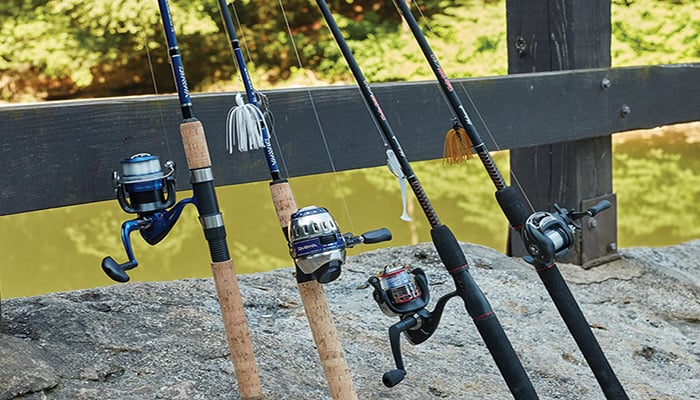
A fishing rod is a long, flexible rod used in the sport of fishing to catch fish. It is a crucial tool for anglers, and its design and components are optimized for various fishing techniques and conditions. A typical fishing rod consists of a long, slender pole with guides (small rings) along its length to guide the fishing line. The rod also has a handle, reel seat, and a reel attached to it.
Table of Contents
What is Fishing rod?
The fishing rod is paired with a fishing reel which is mounted on the reel seat. The reel is used to store and retrieve the fishing line and it often contains a drag system to control the tension on the line. The combination of the rod and reel allows anglers to cast their bait or lures into the water and reel in fish once they are hooked.
Fishing rods come in different lengths, materials, and actions (flexibility). The choice of a fishing rod depends on the type of fishing, the species targeted, and the fishing environment. For example, Siesta Key Fishing Adventures offers expert guidance on choosing the right rod for various types of fishing, including freshwater fishing, saltwater fishing, fly fishing, ice fishing, and more. Anglers select their fishing rod based on factors such as the type of fish they are pursuing, the fishing technique they are using, and personal preferences.
Types of Fishing Rod
There are various types of fishing rods designed for specific fishing techniques, environments, and target species. Here are some common types of fishing rods:
Spinning Rods:
-
- Description: Spinning rods have a reel seat located on the bottom of the rod, and they are designed to work with spinning reels. These rods are versatile and suitable for various fishing applications.
- Common Uses: Spinning rods are popular for freshwater and light saltwater fishing, and they are commonly used for casting lures and bait.
Baitcasting Rods:
-
- Description: Baitcasting rods have the reel seat located atop the rod and are designed to work with baitcasting reels. They offer more accuracy and control, making them suitable for experienced anglers.
- Common Uses: Baitcasting rods are often used for freshwater fishing, especially when targeting larger fish with heavier lures.
Fly Rods:
-
- Description: Fly rods are designed specifically for fly fishing. They are long, lightweight, and flexible, allowing anglers to cast artificial flies using the weight of the fly line.
- Common Uses: Fly rods are used in fly fishing, which is popular in both freshwater and saltwater environments.
Surf Rods:
-
- Description: Surf rods are long, powerful rods designed for casting long distances from the shore into the surf. They are typically used in saltwater fishing.
- Common Uses: Surf rods are employed for surf fishing to catch species that are found along coastal areas.
Ice Fishing Rods:
-
- Description: Ice fishing rods are short rods designed for use on frozen bodies of water. They are compact and often feature specialized features for ice fishing conditions.
- Common Uses: Ice fishing rods are used for fishing through holes drilled in the ice, and they are commonly paired with small reels or used with a simple jigging technique.
Telescopic Rods:
-
- Description: Telescopic rods have a collapsible design, with sections that can be extended or collapsed. They are convenient for traveling and storage.
- Common Uses: Telescopic rods are suitable for various fishing applications and are often chosen by anglers who need a portable option.
Trolling Rods:
-
- Description: Trolling rods are designed for trolling, a fishing technique where lures or baits are pulled behind a moving boat. These rods are often stout and have a parabolic action.
- Common Uses: Trolling rods are commonly used in offshore fishing to target pelagic species.
Buyers Guide for Fishing Rods
When shopping for a fishing rod, it’s important to consider various factors to ensure you choose the right rod for your specific needs and preferences. Here’s a buyer’s guide for fishing rods:
Type of Fishing:
-
- Consider the type of fishing you plan to do, whether it’s freshwater or saltwater, casting lures or bait, and the specific species you’re targeting.
Rod Action:
-
- Rod action refers to the flexibility or stiffness of the rod. Different actions are suitable for different fishing techniques.
- Fast action rods bend mostly at the tip and are more sensitive, making them suitable for techniques requiring quick hook sets.
- Moderate action rods bend more throughout the length, providing a slower response. They are often preferred for fishing with live bait.
Rod Power:
-
- Rod power indicates the amount of force required to bend the rod. It ranges from ultralight to heavy.
- Ultralight rods are suitable for small fish and finesse techniques, while heavy rods are designed for larger fish and heavier lures.
Length of the Rod:
-
- The length of the rod affects casting distance, leverage, and overall control. Longer rods generally cast farther, while shorter rods offer better control in tight spaces.
- Consider the environment and type of fishing when choosing the length of the rod.
Material:
-
- Fishing rods are commonly made of fiberglass, graphite, or a combination of both (composite). Each material has its characteristics.
- Graphite rods are lightweight, sensitive, and provide faster action, while fiberglass rods are more durable and have a slower action.
Reel Seat:
-
- The reel seat is where the reel attaches to the rod. Ensure it is compatible with the type of reel you plan to use (spinning, baitcasting, etc.).
- Check for a sturdy and comfortable reel seat, as it affects the overall feel and performance of the rod.
Guides:
-
- Guides are the small rings along the length of the rod that guide the fishing line. High-quality guides reduce friction and improve casting distance.
- Consider the material of the guides, such as ceramic or stainless steel, and their placement on the rod.
Handle/Grip:
-
- Choose a handle/grip material that provides a comfortable and secure grip during long hours of fishing.
- Handles can be made of cork, EVA foam, or other materials. Consider the design and length of the handle.
Budget:
-
- Set a budget based on your preferences and requirements. Fishing rods come in a wide price range, and there are good options available for various budgets.
Brand and Reviews:
- Research reputable brands with a history of producing quality fishing rods. Read customer reviews to get insights into the performance and durability of specific models.
- Warranty:
- Check the warranty provided by the manufacturer. A good warranty can give you confidence in the quality of the rod.
- Personal Preference:
- Finally, consider your personal preferences. If possible, try handling the rod before purchasing to ensure it feels comfortable and suits your fishing style.
By considering these factors, you can narrow down your options and choose a fishing rod that best meets your needs and enhances your fishing experience.
Read More – Exploring Standup Jet Skiing In Dubai
How to Cast a Fishing Rod
Casting a fishing rod effectively involves a combination of technique, timing, and practice. Here’s a step-by-step guide for casting a fishing rod, assuming you’re using a spinning rod and reel setup:
- Select the Right Lure or Bait:
- Choose a lure or bait suitable for the type of fishing you’re doing and the species you’re targeting.
- Set Up the Reel:
- Open the bail (the wire arm on the reel) and hold the fishing rod with your dominant hand on the rod handle and the other hand on the reel.
- Hold the Rod Properly:
- Grip the rod handle with your dominant hand (usually your right hand) and place your index finger on the bottom of the rod, just below the first guide. Your other fingers should grip the handle comfortably. The reel handle should be facing down.
- Hold the Line:
- Use your index finger to hold the fishing line against the rod just above the reel, known as the “line bale.”
- Prepare for the Cast:
- Position yourself with your feet shoulder-width apart, facing the target area. Keep your body relaxed.
- Loading the Rod:
- Swing the rod backward by bringing your arm backward and turning your body slightly. This motion loads the rod, storing energy for the cast.
- Aim and Release:
- Aim the rod tip at your target and initiate the forward cast by swiftly bringing the rod forward. Release the fishing line with your index finger as the rod moves forward. This action should be smooth and controlled.
- Follow Through:
- Allow the rod to follow through after the forward cast. Extend your arm fully in the direction of the cast. This ensures maximum distance and accuracy.
- Manage the Line:
- Once the lure or bait has landed in the water, use your index finger to control the line on the reel. Close the bail to secure the line.
- Practice:
- Practice is crucial for improving your casting technique. Spend time casting in an open area, gradually increasing the distance as you become more comfortable.
Tips:
- Start with short casts and gradually work on increasing your casting distance.
- Pay attention to your wrist movement; avoid excessive wrist flicking.
- Use the weight of the lure to load the rod properly during the backswing.
- Practice with different lures and baits to get a feel for how each one casts.
Remember that casting techniques can vary depending on the type of reel (spinning, baitcasting, etc.) and the specific fishing situation. If you’re new to fishing, consider seeking guidance from experienced anglers or taking lessons to refine your casting skills.
Read More – Dirt Biking in Dubai
Top 8 fishing rods techniques for beginners
- Spinning Rod Basics:
- Start with a versatile spinning rod for its ease of use and forgiving nature. Perfect for beginners, it accommodates various techniques and is effective for both freshwater and light saltwater fishing.
- Casting with Baitcasting Rods:
- Begin mastering baitcasting rods for more precision. Practice casting in an open area, gradually adjusting the brakes and spool tension to prevent backlash.
- Learn the Art of Fly Fishing:
- Explore the world of fly fishing with a basic fly rod. Focus on mastering the casting techniques, including the roll cast and overhead cast.
- Trolling Techniques:
- Familiarize yourself with trolling methods, especially if you’re targeting species in deeper waters. Learn how to use downriggers and planers for effective trolling.
- Mastering the Art of Jigging:
- Jigging is a versatile technique. Practice the rhythmic motion of lifting and dropping the rod tip to create an enticing motion for lures or bait.
- Perfecting the Flip and Pitch:
- Develop accuracy by mastering the flip and pitch techniques with baitcasting gear. These short-distance casts are ideal for precision in cover-heavy areas.
- Surf Fishing Techniques:
- Understand the nuances of surf fishing with a dedicated surf rod. Learn how to read tides, cast beyond the breakers, and effectively present bait to surf-dwelling species.
- Ice Fishing Rod Essentials:
- Embrace the unique challenges of ice fishing with a short, sensitive ice fishing rod. Practice setting up in cold conditions and learn techniques like jigging and deadsticking.
By gradually exploring these fishing rod techniques, beginners can build a solid foundation and gain confidence in various fishing scenarios.
Conclusion
Mastering the art of casting a fishing rod involves proper technique, precise timing, and dedicated practice. By selecting the right lure, holding the rod correctly, and executing a smooth motion, anglers can achieve accurate and efficient casts. Regular practice, attention to form, and understanding the mechanics of the rod contribute to improved casting skills, enhancing the overall fishing experience.
Follow – https://sggreek.com for More Updates


